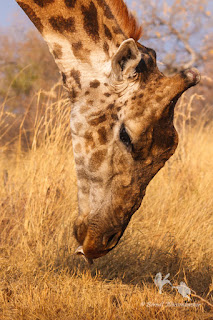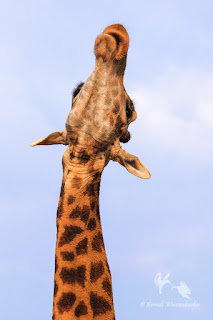A
few years ago, while visiting a very small game reserve at the foot of the
Waterberg Mountains (near Bela-Bela in the Limpopo Province of South Africa), a
bull giraffe that was behaving very oddly indeed piqued my curiosity. This old lord
of the bushveld was standing in a bare patch of veld, his legs splayed apart
slightly, his head held down at ground level. I soon realised that this giraffe
was attempting to gather up a small item from the soil using his thick furry
lips and long tongue. When he eventually lifted his head, to my surprise, a
slither of sun-bleached bone was clenched firmly in his muzzle – then he persisted
in rolling this small piece of bone around inside his mouth, chewing on it and
sucking on it for the next half an hour.
Bone
is an extremely indigestible material. Long-dead bone is essentially a rock, a
type of limestone, composed of a crystalline lattice of calcium phosphate and
calcium carbonate and other inorganic minerals. Of course, bone has an organic
origin; vertebrates produce and lay down bone as an endoskeleton. ‘Living’ bone
contains several types of bone cells, marrow, nerves and blood vessels nestled
within the inorganic, rocklike matrix. The organic substances in living bone potentially
are a concentrated source of nutrients for any carnivore. However, very few
animals eat bone because the vast majority of animals can not digest the bone
matrix efficiently enough to access the nutrients contained within it.
A
few exceptional animals can digest bone, at least partially. Boneworms (of the
genus Osedax) digest the bones of
marine vertebrates (particularly whales) that have settled on the ocean floor.
These deep-sea polychaetes are probably the only animals that are specialised
in their lifestyle and in their digestion to feed off bone almost exclusively. Amongst
birds, lammergeyers have a diet that consists of up to 90% of bone. These birds
can digest bone because they produce incredibly acidic stomach juices (pH < 1!).
They also possess a digestive tract that is significantly longer than that of
other birds of prey is. Moreover, lammergeyers will glide effortlessly (rather
than using flapping flight) even over short distances, thereby reducing energy
expenditure. The combination of these adaptations makes a diet of bone feasible
for these birds. The large hyaena species will also consume bone regularly;
however, this food source never makes up a significant share of their diet.
Detritivores
(such as the boneworms) and carnivores (such as lammergeyers and hyaenas) will devour
‘fresh’ bone that is easier to smash or chew and to digest. Their prize for
doing this is the nutrient-rich marrow of cells and blood. Why would a giraffe,
a vegetarian browser, eat bone?
The habit of animals consuming bones is called osteophagy. Surprisingly
perhaps, given the information above, this behaviour is quite common in
herbivores. Osteophagy has been observed frequently in domestic animals and
wild ungulates (species of deer, camels, giraffes, wildebeest, many other
antelope species), as well as in tortoises, and even in some omnivorous bear
species. Interestingly, herbivores tend to chew on old, dry bone. Dried out bone
(from which bacteria have already removed by decomposition all nutrient-rich cellular
material) contains very little energy or nutritional value (although a few fats
that have not decomposed fully can still be present even in very ancient bones).
Giraffes
are browsers; they feed almost exclusively on leaves of woody vegetation. However,
giraffe are seen chewing on bone frequently. It is hypothesised that osteophagy
allows giraffes (and other herbivores too) to avoid the costly effects of
deficiencies of especially phosphorus and calcium* in their vegetable diet by supplementing their intake of these
elements from a different source, namely bone.
Much of the world’s vegetation contains a low (often insufficient)
concentration of phosphate. The amount of calcium available to herbivores
through their diet is also often limited. The concentration of both of these
elements also varies seasonally depending on the amount of rainfall the
vegetation receives. The lack of sufficient nutrients in the available
vegetation for foraging herbivores is exacerbated in smaller nature reserves
because herbivore numbers are often kept high for the continued presence of
carnivores in these reserves. Moreover, in small reserves there is little or no
scope for even the shortest of local movements by herbivores to other, more nutritious
patches of vegetation.
It seems possible that osteophagy has evolved as an innate behaviour in
herbivores to gain access to vital nutrients. Several niggling conundrums
plague this hypothesis though. There is some evidence, in giraffes at least,
that indicates that the digestion of bone material is inadequate to extract
phosphate and calcium ions from this source. There is also ample evidence that
osteophagy leads to significant, detrimental wear, even breakage, of the
dentition of herbivores. Herbivore dentition is adapted to grinding down tough
plant fibres – plant material (especially the cellulose cell wall material and
any inclusions in it) is much harder to break up physically than animal tissue
(‘meat’) is. Through adaptation, herbivore teeth are equipped with many exposed
crenulations and ridges of very hard tooth enamel, giving the grinding surfaces
of the premolars and molars a rasp-like appearance and function. Yet even small
pieces of hard, sun-bleached bone are usually snapped off or broken apart,
often with significant wear (even damage) to the teeth of herbivores, and can
not be ground down finely enough for the effective digestion of bone material.
I am
a trained zoologist – I have known about osteophagy for a long time and I have
witnessed this behaviour on several occasions. Nevertheless, on this particular
occasion I experienced a strange jolt. I was surprised that the clear and
lengthy view of a herbivore licking, sucking and chewing on a bone somehow seemed
to be amiss. Deep down my subconscious was signalling that this behaviour was
abnormal – cute and cuddly herbivores do not chew on the bones of the dead. No
doubt, the antics of the male giraffe, the contortions of the face and neck
amplified this slight twinge of unease.
* Phosphorus and calcium are
essential minerals for all animals. Both play a major role in the formation and
maintenance of the skeletal system and teeth in vertebrates.
Phosphorus is an essential element in the structure and function of
nucleic acids (DNA and RNA), including protein synthesis, cell division and
heredity. Moreover, phosphorus is necessary for many biological processes
including energy metabolism, cell signalling, and lactation. Phosphate
deficiencies can cause physiological side effects, especially pertaining to the
reproductive system, as well as side effects of delayed growth and failure to
regenerate new bone.
Calcium plays a fundamental role in cell growth and cell division, the transport
of molecules across cell membranes, the transfer of information between cells
and the transmission of nerve impulses along neurons and across neuromuscular
junctions. Calcium is also a vital element required for contraction and relaxation
of muscles, the secretion of hormones and the clotting of blood. Calcium ions
are involved in a host of intracellular enzymatic reactions too. Prolonged
calcium deficiency in young animals may result in rickets, stunted growth and delayed maturity.
In adults, a protracted lack of
calcium in the diet can lead to fragile bones and osteoporosis, rendering bones prone to
fractures. Other symptoms of a calcium deficiency include reduced
fertility, lowered milk production in females, paralytic syndromes and a
general feeling of lethargy and slowness of action, amongst others.






No comments:
Post a Comment